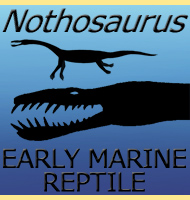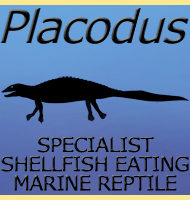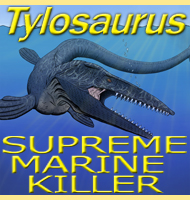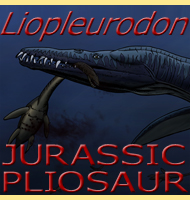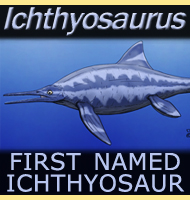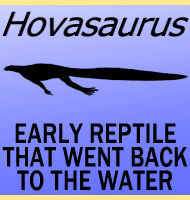


Plesiosaurus
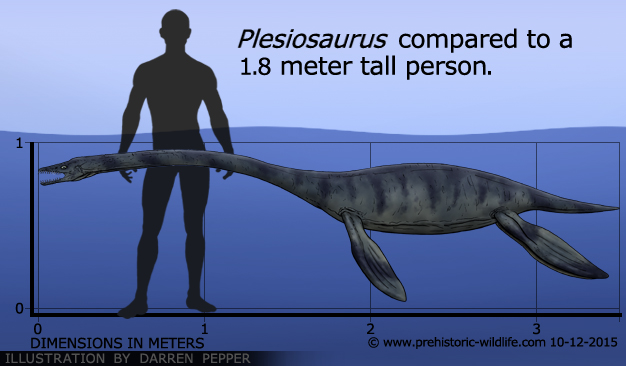
Name:
Plesiosaurus
(Almost lizard).
Phonetic: Pleh-see-oh-sore-us.
Named By: William Conybeare & Henry De la
Beche - 1821.
Classification: Chordata, Reptilia,
Sauropterygia, Plesiosauria, Plesiosauroidea, Plesiosauridae.
Species: P. dolichodeirus
(type).
Diet: Piscivore.
Size: Approximately 3.5 meters long.
Known locations: England - Lias Group.
Time period: Possibly late Rhaetian of the Triassic
through to Sinemurian of the Jurassic.
Fossil representation: Many specimens.
First
and most famous member of the plesiosaur
group, Plesiosaurus
caused
a stir upon its discovery as nothing like it was previously known.
Unfortunately Plesiosaurus suffered from the
wastebasket taxon effect
as any set of remains remotely similar to it ended up being
assigned to the genus without much further thought (a method of
classification that also affected many other prehistoric animals such
as the dinosaur Megalosaurus
and the pterosaur Pterodactylus).
Later study of Plesiosaurus fossils would reveal
that many of these
remains actually represented completely different plesiosaurs. New
plesiosaur genera created from the re-classification of plesiosaurus
species include Hydrorion
and Seeleyosaurus. Some fossils of Plesiosaurus
were renamed as the genus Occitanosaurus, but that
genus has now been
synonymised with Microcleidus.
How
long Plesiosaurus spent in the water has long been
a matter of debate.
Classical art and reconstructions from the early years of marine
reptile palaeontology depicted it as being just as capable of walking
about on land as it could swim in the ocean. Also the long neck was
almost always depicted as shooting out from the water and arcing around
in strong curves, but today both of these depictions are thought to
be highly unlikely.
The
limbs of Plesiosaurus which were once legs in its
ancestors have
evolved into flippers which are actually quite stiff. This makes them
better for paddling through the water, but cumbersome on land, and
certainly not likely to be capable of lifting Plesiosaurus’s
body off
the ground. At best Plesiosaurus would be capable
of pulling its body
with the front flippers while pushing with the rear. This may make it
capable of leaving the water but not for any great distance inland.
Possibly more likely is Plesiosaurus pushing
itself through the
shallows where the water was not deep enough to float its entire body
but still capable of supporting some of the weight and the bulk so that
the flippers did not have to ‘lift’ as much.
The
construction and makeup of the neck itself is actually taken as the
strongest evidence for an entirely if not almost entirely aquatic
lifestyle. Long presumed by many people to be capable of bending in
strong curves, reconstruction of the vertebrae has revealed that the
neck was surprisingly inflexible with only gentle arcs along the entire
length of the neck being possible. This means that the neck was most
stable when projecting horizontally level forwards. This also means
that Plesiosaurus probably could not carry its head
and neck high off
the ground should it ever leave the water, and if it ever did the
head and neck may have had to be rested on the ground to support the
weight and bulk which the neck muscles were incapable of doing without
the buoyant support of surrounding water.
It’s
most likely that the neck was long in order to afford Plesiosaurus
additional reach to strike out at prey. Given the necks inherent
weakness and inflexibility the older theories depicting Plesiosaurus
shooting its head and neck into the air and arcing down onto a shoal of
fish are no longer considered accurate. Instead Plesiosaurus
may have
approached prey from the side or even below, hiding its large body in
the murk of the lower depths so that fish did not realise the danger.
The latter theory is often proposed for the elasmosaurid group of
plesiosaurs that had the proportionately longest necks of all the
plesiosaurs.
If
Plesiosaurus was capable and if so how long it spent
on land has also
been part of the argument of whether it laid eggs or gave birth to live
young. Plesiosaurus may have struggled its way up
a beach like
turtles do today, possibly even using a high tide to carry it as far
up the shore as it was able to reach and then laying eggs in the sand
just beyond the tidal reach. Such behaviour would have been risky as
Plesiosaurus would likely need the tides to carry it
back out to sea,
and may have been vulnerable to terrestrial predators in the process.
While
the above is a viable theory, it needs to be remembered that the
precedent for live birth exists in other marine reptiles, and may go
back to the plesiosaur ancestors the nothosaurs,
as indicated by
potential fossil material of the small nothosaur Lariosaurus.
If live
birth is the case for Plesiosaurus, then it’s a
reasonable
proposition that it may never have ventured onto land and spent its
entire life in the water.
Further reading
- A revision of the classification of the Plesiosauria with a synopsis
of the stratigraphical and geographical distribution of the group -
Lunds Universitets �rsskrift, N. F. Avd. 2. 59, 1-59 - P. O. Persson -
1963.
- The English Upper Jurassic Plesiosauroidea (Reptilia) and a review of
the phylogeny and classification of the Plesiosauria - Bulletin of the
British Museum (Natural History) 35(4):253-347 - D. S. Brown - 1981.
- Dorsal nostrils and hydrodynamically driven underwater olfaction in
plesiosaurs - Nature, 352, 62-64 - A. R. I. Cruickshank, P. G. Small
& M. A. Taylor - 1991.
- Morphological and taxonomic clarification of the genus Plesiosaurus
-
G. W. Storrs - 1997 - In Ancient Marine Reptiles 145-190 - J. M.
Callaway & E. Nicholls (eds).
- Reevaluation of the holotype of Plesiosaurus (Polyptychodon)
mexicanus, Wieland, 1910 from the Upper Jurassic of
Mexico: a
thalattosuchian, not a sauropterygian - Revista Mexicana de Ciencias
Geol�gicas 25(3):517-522 - M. -C. Buchy - 2008.
----------------------------------------------------------------------------
Random favourites
 |
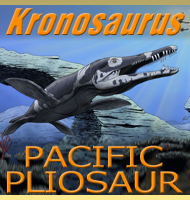
|
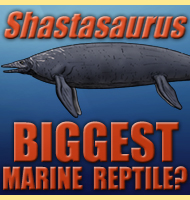
|

|

